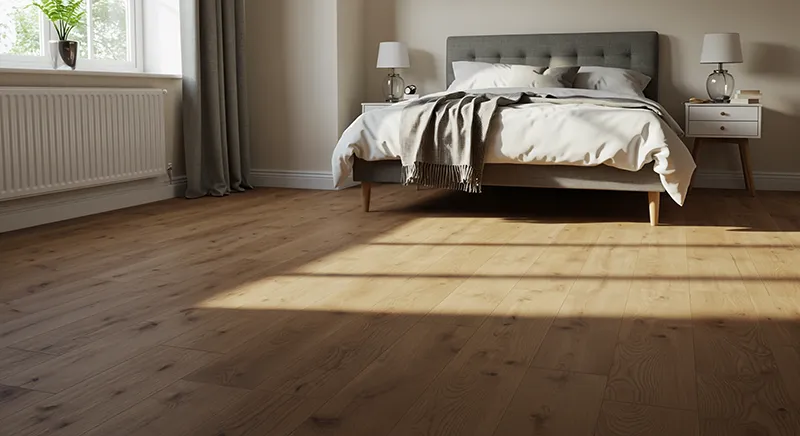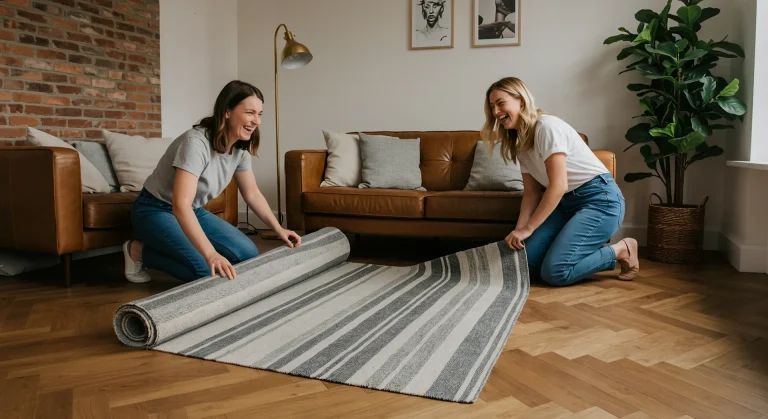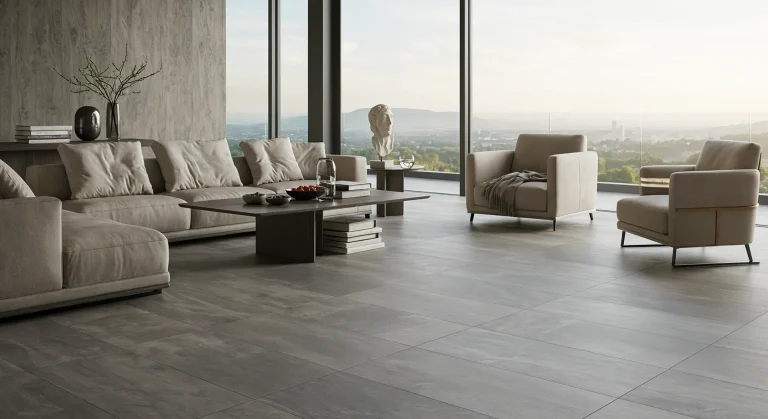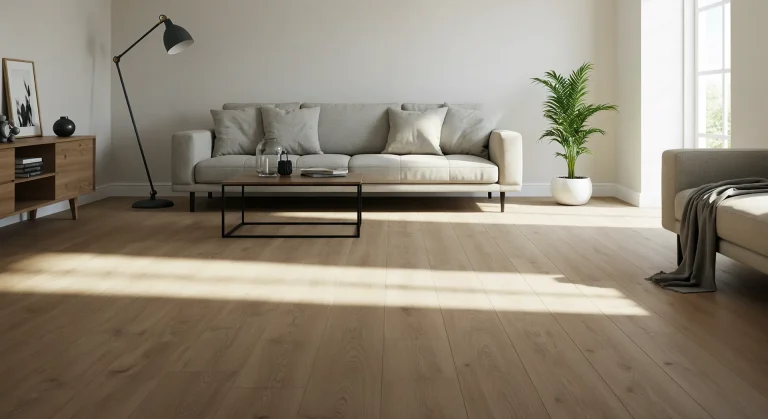Laminate flooring remains a hugely popular choice for UK homeowners, offering a fantastic combination of style, durability, and affordability. When selecting your new laminate, you’ll encounter various specifications, but one of the most crucial, yet often misunderstood, is laminate flooring thickness. Does thicker always mean better? How does thickness impact performance, feel, and even installation? And what’s the right choice for your specific needs and rooms in 2025?
This ultimate UK guide will demystify laminate flooring thickness. We’ll explore the common thicknesses available on the market (from budget-friendly 6mm to premium 12mm and beyond), explain exactly how thickness affects everything from durability and sound insulation to comfort underfoot and suitability for underfloor heating. By understanding the nuances of laminate flooring thickness, you can make an informed decision that ensures your new floor not only looks great but also performs brilliantly for years to come.
Jump to Section:
- Understanding Laminate Flooring Thickness: More Than Just a Number
- Common Laminate Thicknesses in the UK: From 6mm to 12mm and Beyond
- The Impact of Thickness: How It Affects Your Laminate Floor’s Performance
- Is Thicker Always Better? Weighing Up the Pros and Cons
- Best Laminate Thickness for Different UK Rooms & Needs (2025)
- Thickness and Underlay: Finding the Right Combination
- Cutting Concerns: Does Thickness Affect Laminate Installation?
- Laminate Flooring Thickness & Cost: What to Expect in the UK
- Making the Right Choice: Selecting Your Ideal Laminate Thickness
Understanding Laminate Flooring Thickness: More Than Just a Number
When we talk about laminate flooring thickness, we’re referring to the overall thickness of an individual laminate plank, measured from the very bottom (backing layer) to the very top of the protective wear layer. It’s important to distinguish this from the “wear layer thickness” itself, which is a separate measure usually associated with AC ratings (Abrasion Class) that define surface scratch and scuff resistance.
Laminate flooring is a composite material made up of several layers:
- Wear Layer: A clear top coat protecting against scratches and stains.
- Decor Layer: A high-resolution image of wood, stone, or tile.
- Core Layer (HDF): High-Density Fibreboard forms the bulk of the plank and contributes most to its overall thickness and structural integrity.
- Backing Layer: Provides stability and some moisture resistance from below.
The thickness of the HDF core is the primary determinant of overall plank thickness and significantly influences many of its performance characteristics.
Common Laminate Thicknesses in the UK: From 6mm to 12mm and Beyond
In the UK market for 2025, you’ll typically find laminate flooring thickness options ranging from around 6mm up to 12mm, with some premium products occasionally reaching 14mm or more:
- 6mm – 7mm: This is the budget end of the spectrum. Often chosen for projects where cost is the primary driver or for very light traffic areas. It’s less forgiving of subfloor imperfections and requires a very level base.
- 8mm: A very popular and widely available mid-range thickness in the UK. It offers a good balance of affordability, durability for general domestic use, and a reasonably solid feel underfoot, provided a good quality underlay is used.
- 10mm: This thickness provides a noticeable step up in quality. Planks feel more substantial, offer better sound insulation, are more stable, and can bridge minor subfloor irregularities more effectively than thinner options. Good for higher traffic areas.
- 12mm: Considered a premium thickness. Offers a very solid, wood-like feel, excellent acoustic properties (less ‘clicky’ noise), maximum impact resistance, and the best ability to cope with slight subfloor imperfections (though a level subfloor is always ideal).
- 14mm+: Less common and typically found in high-end ranges, offering ultimate robustness and a very substantial feel.
The Impact of Thickness: How It Affects Your Laminate Floor’s Performance
The chosen laminate flooring thickness has a direct impact on several key aspects:
Durability, Stability, and Impact Resistance
A thicker HDF core generally means a more robust and durable plank. Thicker planks are less likely to flex under load, which puts less stress on the click-lock joints, potentially leading to a longer-lasting installation with fewer creaks or gaps forming over time. They also offer better resistance to dents from dropped objects or heavy furniture due to the increased density and mass of the core.
Feel Underfoot and Reducing That ‘Hollow’ Sound
One common criticism of thinner laminate can be a ‘hollow’ or ‘clicky’ sound when walked upon, and a slightly insubstantial feel. Thicker laminate (10mm and especially 12mm), particularly when paired with a good quality underlay, significantly mitigates this. It provides a more solid, satisfying feel underfoot, much closer to that of engineered or solid wood, and offers better sound absorption, reducing both impact noise (footsteps) and reflected room noise.
Forgiving Minor Subfloor Imperfections
While a perfectly level subfloor is always the ideal foundation, thicker and therefore more rigid laminate planks (10mm+) have a greater ability to ‘bridge’ very minor undulations or imperfections in the subfloor without flexing excessively. This can be particularly beneficial in older UK properties where subfloors may not be perfectly flat. However, it’s crucial to understand that even the thickest laminate is not a substitute for proper subfloor preparation – significant dips or bumps must still be addressed.
Is Thicker Always Better? Weighing Up the Pros and Cons
While thicker laminate generally offers enhanced performance, there are trade-offs:
Pros of Thicker Laminate (10mm, 12mm+):
- More solid and stable feel underfoot.
- Better sound insulation (less ‘clicky’).
- Higher impact and dent resistance.
- More robust click-lock joints.
- Can better manage very minor subfloor imperfections.
- Often perceived as higher quality.
Cons of Thicker Laminate:
- Higher Cost: Thicker laminate uses more material and is generally more expensive per square metre.
- Increased Floor Height: The combined height of thicker laminate and its underlay will be greater. This can impact:
– Door clearances (doors may need to be trimmed).
– Transitions to other existing flooring types.
– Skirting board heights. - Heavier to Handle: Thicker planks are heavier, which can make DIY installation slightly more physically demanding.
- Underfloor Heating (UFH) Efficiency: While most laminate itself has a low Tog rating (good for UFH), very thick laminate combined with a thermally insulating underlay could slightly reduce the responsiveness or efficiency of UFH if the total Tog value becomes too high. However, this is usually more dependent on the underlay choice. Always check manufacturer recommendations for UFH compatibility.
Best Laminate Thickness for Different UK Rooms & Needs (2025)
Choosing the best laminate flooring thickness involves matching it to the room’s use and your expectations:
- Bedrooms & Light Traffic Areas: 6mm or 7mm can be acceptable if the subfloor is perfectly level and budget is a primary concern. However, 8mm is generally recommended as a better starting point for improved feel and durability even in these areas.
- Living Rooms, Dining Rooms (General Domestic Traffic):8mm is a popular all-rounder. 10mm laminate is often preferred for these spaces as it offers a noticeable improvement in solidity, sound insulation, and overall quality feel.
- Hallways & High Traffic Areas:10mm to 12mm is highly recommended. These areas experience the most wear, and the enhanced stability and impact resistance of thicker laminate will pay dividends in longevity and appearance.
- With Underfloor Heating (UFH): Most laminate thicknesses are suitable as the HDF core generally has low thermal resistance. The key is pairing it with a specialist low-Tog rated UFH underlay. However, always consult both the laminate and UFH system manufacturer’s guidelines.
- Over Slightly Imperfect Subfloors: If your subfloor has very minor, unavoidable undulations (after attempting to level it as much as possible), 10mm or 12mm laminate will offer better bridging capabilities than thinner options.
Thickness and Underlay: Finding the Right Combination
Remember, laminate flooring thickness is only part of the equation; underlay is always essential.
- Underlay typically adds another 2mm to 5mm to the overall floor height. Factor this in when considering door clearances.
- Don’t try to compensate for a thin laminate by using an overly thick or spongy underlay (like carpet underlay). This can cause the click joints to flex too much and fail. Stick to underlays specifically designed for laminate, within the laminate manufacturer’s recommended thickness range.
- The combined performance of your chosen laminate thickness and the right quality underlay will determine the final comfort, sound, and stability of your floor.
Cutting Concerns: Does Thickness Affect Laminate Installation?
Yes, laminate flooring thickness can influence the cutting process:
- 6mm – 8mm: Can often be cut reasonably well with a sharp utility knife (score and snap method, though not always ideal for perfectly clean edges) or a hand saw, but a dedicated laminate cutter or fine-toothed jigsaw/circular saw is still preferable.
- 10mm – 12mm+: Significantly harder to score and snap effectively with a utility knife. A good quality laminate cutter (guillotine style) becomes almost essential for clean, quick straight cuts. For angled or intricate cuts, a fine-toothed jigsaw or mitre saw is necessary. These thicker planks are also heavier to manoeuvre.
Laminate Flooring Thickness & Cost: What to Expect in the UK
Generally, the thicker the laminate, the higher the material cost. Here are approximate UK price ranges for materials in 2025:
- 6mm – 7mm: £8 – £15 per m²
- 8mm: £12 – £20 per m²
- 10mm: £15 – £25 per m²
- 12mm+: £20 – £35+ per m²
These are indicative; prices vary significantly by brand, AC rating, water resistance features, design complexity (e.g., herringbone), and retailer. Always factor in the cost of quality underlay (£3-£7/m²) and other accessories.
Making the Right Choice: Selecting Your Ideal Laminate Thickness
Choosing the right laminate flooring thickness for your UK home involves balancing your budget with the demands of the room and your desired level of quality and comfort. While an 8mm AC4-rated laminate is a versatile and popular workhorse for many domestic situations, stepping up to 10mm or 12mm offers tangible benefits in terms of solidity, sound reduction, impact resistance, and a more premium feel underfoot, making it an excellent investment for higher traffic areas or for those seeking a superior finish.
Always consider the subfloor condition – a perfectly level subfloor allows more flexibility with thinner laminates, whereas older, slightly uneven subfloors (common in many UK properties, including some charming older homes in various regions) benefit from the rigidity of thicker planks. By understanding the implications of different laminate flooring thicknesses and pairing your choice with the correct, high-quality underlay, you can ensure a beautiful, durable, and comfortable floor that enhances your home for years to come.

 Light
Light Grey
Grey Natural
Natural Dark
Dark White
White Light
Light Grey
Grey Natural
Natural Dark
Dark Black
Black










